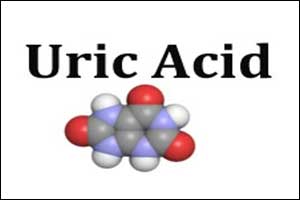- Home
- Editorial
- News
- Practice Guidelines
- Anesthesiology Guidelines
- Cancer Guidelines
- Cardiac Sciences Guidelines
- Critical Care Guidelines
- Dentistry Guidelines
- Dermatology Guidelines
- Diabetes and Endo Guidelines
- Diagnostics Guidelines
- ENT Guidelines
- Featured Practice Guidelines
- Gastroenterology Guidelines
- Geriatrics Guidelines
- Medicine Guidelines
- Nephrology Guidelines
- Neurosciences Guidelines
- Obs and Gynae Guidelines
- Ophthalmology Guidelines
- Orthopaedics Guidelines
- Paediatrics Guidelines
- Psychiatry Guidelines
- Pulmonology Guidelines
- Radiology Guidelines
- Surgery Guidelines
- Urology Guidelines
Uric Acid: Both High and Low levels predict increased mortality

Both low and high uric acid levels were predictive of increased mortality, showing a U‐shaped association between serum uric acid levels and adverse health outcomes, suggests a recent study.
Sung Kweon Cho et. al conducted a study to evaluate the relationship between both low and high uric acid levels and the risk of all‐cause and cause‐specific mortality in a large sample of Korean adults over a full range of uric acid levels. The study was performed in 375,163 South Korean men and women who underwent health check‐ups from 2002 to 2012. Their vital status and cause of death were ascertained from the national death records.
The Key findings of research were-
- Among men with the highest levels, the hazard ratios for cardiovascular and cancer mortality were 3.76 and 2.67, respectively
- Among women with the highest levels, the hazard ratio for cardiovascular mortality was 11.44.
- Among men with the lowest levels, the hazard ratios for cardiovascular and cancer mortality were 1.50 and 1.38 respectively neither of which was significant.
- For women with the lowest levels, the hazard ratios for cardiovascular and cancer mortality were 3.96 and 1.58 with the latter not being significant.
- the U-shaped association between uric acid levels and all-cause mortality had inflection points at approximately 7 mg/dL for men and 4 mg/dL for women.
- Association between uric acid levels and mortality showed no interactions with alcohol or smoking, exercise, body mass index, or comorbidities including diabetes and chronic kidney disease.
Increased uric acid levels lead to gout and kidney stones and may contribute to hypertension, cardiovascular disease, metabolic syndrome, and kidney ailments. At the same time, uric acid is also an antioxidant and low levels can result in oxidative stress and endothelial dysfunction, which can predispose to illnesses such as hypertension and diabetes.
The study hypothesized that individuals with hypouricemia have higher chances of developing atherosclerotic diseases due to decreased antioxidant potential and the induction of cancer cell proliferation was observed in low uric acid conditions through reactive oxygen species production in a mouse model.
Hyperuricemia may lead to mortality due to oxidative stress and the inflammation. Hyperuricemia can activate the NLRP3 inflammasome and induce the production of interleukin-1Β which in turn leads to an inflammatory cascade. Intracellular hyperuricemia also generates inflammatory stress from reactive oxygen species/reactive nitrogen species generation and cyclooxygenase 2 activation
The study concluded that there was an increased risk for all-cause mortality with low uric acid for both men and women, as well as an increased risk for cancer mortality in men and cardiovascular mortality in women.
The study was published in the journal Arthritis and Rheumatology
For more reference log on to https://doi.org/10.1002/art.40472

Disclaimer: This site is primarily intended for healthcare professionals. Any content/information on this website does not replace the advice of medical and/or health professionals and should not be construed as medical/diagnostic advice/endorsement or prescription. Use of this site is subject to our terms of use, privacy policy, advertisement policy. © 2020 Minerva Medical Treatment Pvt Ltd